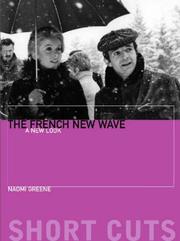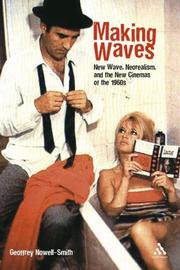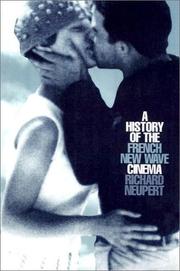| Listing 1 - 10 of 40 | << page >> |
Sort by
|
Book
ISBN: 9781501360404 Year: 2021 Publisher: New York : Bloomsbury Academic,
Abstract | Keywords | Export | Availability | Bookmark
 Loading...
Loading...Choose an application
- Reference Manager
- EndNote
- RefWorks (Direct export to RefWorks)
"As a period of film history, The American New Wave (ordinarily understood as beginning in 1967 and ending in 1980) remains a preoccupation for scholars and audiences alike. In traditional accounts, it is considered to be bookended by two periods of conservatism, and viewed as a (brief) period of explosive creativity within the Hollywood system. From Bonnie and Clyde to Heaven's Gate, it produced films that continue to be watched, discussed, analysed and poured over. It has, however, also become rigidly defined as a cinema of director-auteurs who made a number of aesthetically and politically significant films. This has led to marginalization and exclusion of many important artists and filmmakers, as well as a temporal rigidity about what and who is considered part of the 'New Wave proper'. This collection seeks to reinvigorate debate around this area of film history. It also looks in part to demonstrate the legacy of aesthetic experimentation and political radicalism after 1980 as part of the 'legacy' of the New Wave. Thanks to important new work that questions received scholarly wisdom, reveals previously marginalised filmmakers (and the films they made), considers new genres, personnel, and films under the banner of 'New Wave, New Hollywood', and reevaluates the traditional approaches and perspectives on the films that have enjoyed most critical attention, New Wave, New Hollywood: Reassessment, Recovery, Legacy looks to begin a new discussion about Hollywood cinema after 1967"--
New wave films --- Motion pictures --- History and criticism. --- History --- Nouvelle Vague (cinéma) --- Nouvelle Vague (cinéma)
Book
ISBN: 9781501369124 1501369091 1501369121 9781501369094 Year: 2022 Publisher: New York, NY : Bloomsbury Academic,
Abstract | Keywords | Export | Availability | Bookmark
 Loading...
Loading...Choose an application
- Reference Manager
- EndNote
- RefWorks (Direct export to RefWorks)
The New Wave Cinema in Iran is a historical and analytical study of the Iranian New Wave Cinema (Mowj-e No) as an artistic and intellectual movement that came to its best early productions between 1958 and 1978. As the movement has a long history, Parviz Jahed focuses on the development and the early progression of the movement in the 1960s and explores its emergence and development in the context of the cultural and social conditions of Iran during this period.Jahed first defines the term 'New Wave' in Iran's film culture, in order to identify the root elements that gave traction to this movement. He analyses the degree to which different elements and factors have contributed to the formation of this cinema, accounting for the different approaches of Iranian intellectual filmmakers towards modernity and a modern form of cinema in Iran. The book finishes by studying the works of three intellectual figures and influential filmmakers of the 1960s, Ebrahim Golestan, Farrokh Ghaffari, and Feraydoon Rahnama, who are arguably considered the forerunners of the New Wave Cinema in Iran.
Cinéma --- Nouvelle Vague (cinéma) --- Motion pictures --- New wave films --- History
Book
ISBN: 9781839022296 9781839022302 Year: 2022 Publisher: New-York ; London : Bloomsbury,
Abstract | Keywords | Export | Availability | Bookmark
 Loading...
Loading...Choose an application
- Reference Manager
- EndNote
- RefWorks (Direct export to RefWorks)
The French New Wave is an essential anthology of writings by and about the critics and filmmakers of this revolutionary cinematic movement, which has had a radical impact on film practice and the way we think and write about film. The volume includes foundational writings such as Francois Truffaut's A Certain Tendency in French Cinema and Andre Bazin's La Politique des auteurs, as well writings by Jean-Luc Godard, Claude Chabrol and Alexandre Astruc.This new edition now represents writings by and about women critics and film-makers, including important articles by the critics Evelyne Sullerot, Michele Firk and Françoise Aude, addressing issues of gender and representation, as well as considering New Wave films in the context of contemporary political events, notably France's colonialist war on the Algerian independence movement. To accompany the case study of Godard's À bout de souffle, the new edition includes a case study of the critical reception of two films by Agnès Varda: La Pointe Courte and Cléo de 5 à 7 .The articles have been specially translated for the volume by Peter Graham, and some are published for the first time in English. These classic writings are accompanied by contextualising introductions by Ginette Vincendeau, updated for this new edition, to form a unique resource on this key cinematic movement and its practitioners.
New wave films --- History and criticism. --- Motion pictures --- History --- Nouvelle Vague (cinéma) --- Histoire et critique --- Nouvelle Vague (cinéma)

ISBN: 9781905674121 1905674120 Year: 2007 Volume: 38 Publisher: London Wallflower
Abstract | Keywords | Export | Availability | Bookmark
 Loading...
Loading...Choose an application
- Reference Manager
- EndNote
- RefWorks (Direct export to RefWorks)
"The French New Wave was perhaps the biggest - and briefest - explosion in the history of world cinema. To understand this important movement, this volume first traces the social and cultural changes of post-war France that led to the New Wave before examining in detail artists such as Alain Resnais, Francois Truffaut and Jean-Luc Godard, and such films as Le beau Serge (1959) and Cleo de 5 a 7 (1961)."--BOOK JACKET.
Film --- France --- New wave films --- Motion pictures --- Motion picture producers and directors --- Nouvelle vague (Cinéma) --- Nouvelle Vague (Cinéma) --- Cinéma --- Producteurs et réalisateurs de cinéma --- History and criticism. --- Philosophy. --- Aesthetics. --- History. --- Histoire et critique --- Philosophie --- Esthétique --- Histoire --- Motion pictures, French. --- Nouvelle vague (Cinéma) --- Nouvelle Vague (Cinéma) --- Cinéma --- Producteurs et réalisateurs de cinéma --- Esthétique --- Nouvelle vague (cinéma) --- Réalisateurs de cinéma --- Nouvelle vague (cinéma) --- Réalisateurs de cinéma

ISBN: 9780826418197 0826418198 9780826418203 0826418201 Year: 2007 Publisher: New York Continuum
Abstract | Keywords | Export | Availability | Bookmark
 Loading...
Loading...Choose an application
- Reference Manager
- EndNote
- RefWorks (Direct export to RefWorks)
New wave films --- History and criticism. --- film --- fimgeschiedenis --- nouvelle vague --- sixties --- twintigste eeuw --- Frankrijk --- Italië --- 791.43 --- History and criticism --- Nouvelle Vague (Cinéma) --- Nouvelle Vague (Cinéma) --- Film --- anno 1960-1969 --- Histoire et critique --- New wave (Motion pictures) --- New wave cinema --- Nouvelle vague (Motion pictures) --- Nouvelles vagues (Motion pictures) --- Motion pictures
Book
ISBN: 9780199858286 9780199858309 Year: 2013 Publisher: Oxford Oxford university press
Abstract | Keywords | Export | Availability | Bookmark
 Loading...
Loading...Choose an application
- Reference Manager
- EndNote
- RefWorks (Direct export to RefWorks)
film --- globalisering --- film en globalisering --- nouvelle vague --- new wave --- Taiwan --- China --- twintigste eeuw --- eenentwintigste eeuw --- 791.43

ISBN: 0299181642 029918160X 9780299217044 0299217043 9786612594717 0299217035 1282594710 9780299217037 9781282594715 6612594713 Year: 2007 Publisher: Madison, Wis. University of Wisconsin Press
Abstract | Keywords | Export | Availability | Bookmark
 Loading...
Loading...Choose an application
- Reference Manager
- EndNote
- RefWorks (Direct export to RefWorks)
Motion pictures --- Cinéma --- History. --- Histoire --- Nouvelle vague (cinéma) --- Cinéma --- New wave (Motion pictures) --- New wave cinema --- Nouvelle vague (Motion pictures) --- Nouvelles vagues (Motion pictures) --- Film --- anno 1960-1969 --- anno 1950-1959 --- France --- New wave films --- History --- History and criticism. --- #SBIB:309H1326 --- Cinema --- Feature films --- Films --- Movies --- Moving-pictures --- Audio-visual materials --- Mass media --- Performing arts --- Films met een amusementsfunctie en/of esthetische functie: genres en richtingen --- History and criticism --- Nouvelle Vague (cinéma)
Book
ISBN: 9781844677603 1844677605 Year: 2011 Publisher: London Verso
Abstract | Keywords | Export | Availability | Bookmark
 Loading...
Loading...Choose an application
- Reference Manager
- EndNote
- RefWorks (Direct export to RefWorks)
The crucible -- The yellow years -- Marble to modern chemistry -- Politicization -- Red notebooks -- The Daney years -- The mainstream -- After Cahiers -- Afterword -- Index of names and films cited.
Motion pictures --- Periodicals --- History. --- Cahiers du cinéma --- film --- 791.43 --- Frankrijk --- nouvelle vague --- filmtheorie --- filmgeschiedenis --- filmtijdschriften --- twintigste eeuw --- Cahiers du Cinéma --- History --- Cahiers du cinéma
Book
ISBN: 9781789761863 Year: 2023 Publisher: Liverpool : Liverpool University Press,
Abstract | Keywords | Export | Availability | Bookmark
 Loading...
Loading...Choose an application
- Reference Manager
- EndNote
- RefWorks (Direct export to RefWorks)
This first comprehensive English collection of the interviews of Jacques Rivette (19282016) documents his career through chronology, filmography, bibliography, and image stills. A comprehensive introduction places this work in the wider context of twentieth-century social change. Rivettes films, like many of the works of the French New Wave, seem to have avoided the aging process entirely, remaining as playful, fresh, and quietly spectacular as the day they were made. Indeed, his body of work may be the most impressive of the French New Wave. Celine and Julie Go Boating (1974) has been recognized as possibly the best film to emerge from the post-New Wave era, even as Paris Belongs to Us (1961) is one of the best pictures to emerge from the New Wave itself. Rivette was hardly the most prolific director, however, and the length of his films has often counted against him. Nonetheless, his clinical, self-reflexive essays in film form reveal him as a cinematic purist whose commitment to the celluloid muse hardly diminished from the heady days of the early 1950s to the end of his career in 2009. Beyond inspiring the New Wave movement and continuing to reflect, and reflect on, its central tenets, Rivettes enduring contribution to the history of film is unquestionably evident in his sensitive treatment of the histories and destinies of women, especially through strong roles for actresses. During the six decades of his career, nonetheless, he struck a subtle balance not only between female and male characters, but also between political and personal obsession, between myth and fiction, between theater and cinema, in films that, in addition to having influenced such contemporary filmmakers as Claire Denis, Jim Jarmusch, Olivier Assayas, and David Lynch, continue to redefine the art of cinema around the world.
Nouvelle Vague (cinéma) --- Rivette, Jacques, --- Critique et interprétation. --- Réalisateurs de cinéma --- Criticism and interpretation. --- Motion pictures --- Motion picture producers and directors --- New wave films --- History
Book
ISBN: 9780857459015 9780857451262 0857459015 085745126X 9780857459220 0857459228 Year: 2013 Publisher: New York : Berghahn Books,
Abstract | Keywords | Export | Availability | Bookmark
 Loading...
Loading...Choose an application
- Reference Manager
- EndNote
- RefWorks (Direct export to RefWorks)
New wave films --- Motion pictures --- Surrealism in motion pictures. --- Nouvelle Vague (Cinéma) --- Cinéma --- Surréalisme dans le cinéma --- History --- Histoire
| Listing 1 - 10 of 40 | << page >> |
Sort by
|

 Search
Search Feedback
Feedback About UniCat
About UniCat  Help
Help News
News